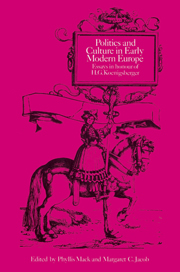Book contents
- Frontmatter
- Contents
- Introduction
- The court of the Spanish Habsburgs: a peculiar institution?
- The magnificent Lorenzo de' Medici: between myth and history
- Political rhetoric and poetic meaning in Renaissance culture: Clément Marot and the Field of Cloth of Gold
- The unlikely Machiavellian: William of Orange and the princely virtues
- The Estates of Brabant to the end of the fifteenth century: the make-up of the assembly
- Presents and pensions: a methodological search and the case study of Count Nils Bielke's prosecution for treason in connection with gratifications from France
- Between Bruni and Machiavelli: history, law and historicism in Poggio Bracciolini
- Constitutional discourse in France, 1527–1549
- Lieuwe van Aitzema: a soured but knowing eye
- John Calvin's contribution to representative government
- Luther and the humanists
- Scholars and ecclesiastical history in the Early Modern period: the influence of Ferdinando Ughelli
- ‘By an Orphean charm’: science and the two cultures in seventeenth-century England
- The crisis of the European mind: Hazard revisited
- Isaac Beeckman and music
- Decadence, shift, cultural changes and the universality of Leonardo da Vinci
- Bibliography of the writings of HELMUT GEORG KOENIGSBERGER
- Index
The court of the Spanish Habsburgs: a peculiar institution?
Published online by Cambridge University Press: 20 October 2009
- Frontmatter
- Contents
- Introduction
- The court of the Spanish Habsburgs: a peculiar institution?
- The magnificent Lorenzo de' Medici: between myth and history
- Political rhetoric and poetic meaning in Renaissance culture: Clément Marot and the Field of Cloth of Gold
- The unlikely Machiavellian: William of Orange and the princely virtues
- The Estates of Brabant to the end of the fifteenth century: the make-up of the assembly
- Presents and pensions: a methodological search and the case study of Count Nils Bielke's prosecution for treason in connection with gratifications from France
- Between Bruni and Machiavelli: history, law and historicism in Poggio Bracciolini
- Constitutional discourse in France, 1527–1549
- Lieuwe van Aitzema: a soured but knowing eye
- John Calvin's contribution to representative government
- Luther and the humanists
- Scholars and ecclesiastical history in the Early Modern period: the influence of Ferdinando Ughelli
- ‘By an Orphean charm’: science and the two cultures in seventeenth-century England
- The crisis of the European mind: Hazard revisited
- Isaac Beeckman and music
- Decadence, shift, cultural changes and the universality of Leonardo da Vinci
- Bibliography of the writings of HELMUT GEORG KOENIGSBERGER
- Index
Summary
According to Lord Herbert of Cherbury – but can his story really be true? – Philip II of Spain once saw fit to rebuke one of his ambassadors for neglecting some piece of business in Italy because of a disagreement with the French ambassador over a point of honour. How, he asked his ambassador, had he “left a business of importance for a ceremony?” The ambassador boldly replied to his master como por una ceremonia? Vuessa Majesta misma no es sino una ceremonia. “How, for a ceremony? Your Majesty's self is but a ceremony”.
The elaborately ceremonious character of Spanish court life was notorious among Europeans of the late sixteenth centuries. But if they laughed, they also imitated. Charles I of England, deeply impressed by his experiences on his visit to Madrid as Prince of Wales in 1623, introduced a decorum into the ceremonial of the English court which bid fair to outdo that of the Spaniards. Yet in spite of the pervasive influence of Spanish manners and ceremonial in Early Modern Europe, all too little is known about the character and organization of the court of the Spanish Habsburgs, and the ways in which it developed. From Saint-Simon to Norbert Elias it is the court of Louis XIV of France that has been taken as the archetype of courtly society in the age of absolutism.
- Type
- Chapter
- Information
- Politics and Culture in Early Modern EuropeEssays in Honour of H. G. Koenigsberger, pp. 5 - 24Publisher: Cambridge University PressPrint publication year: 1987
- 8
- Cited by

